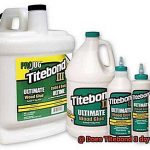Imagine this: you’re knee-deep in a thrilling DIY project on a bone-chilling winter day when suddenly, out of nowhere, a question pops into your head – just how cold is too cold for Super Glue? Well, my curious comrades, today we embark on an icy adventure to uncover the answer to that very question.
Super Glue, or cyanoacrylate as the fancy folks call it, is a powerful adhesive that bonds things together faster than you can say “frostbite.” But even this super glue has its limits when it comes to braving extreme temperatures. In this blog post, we’ll unravel the scientific mysteries behind Super Glue’s frosty struggles, explore how low temperatures affect its bond strength, and find out if your freezing winter escapades might put this trusty adhesive to the test.
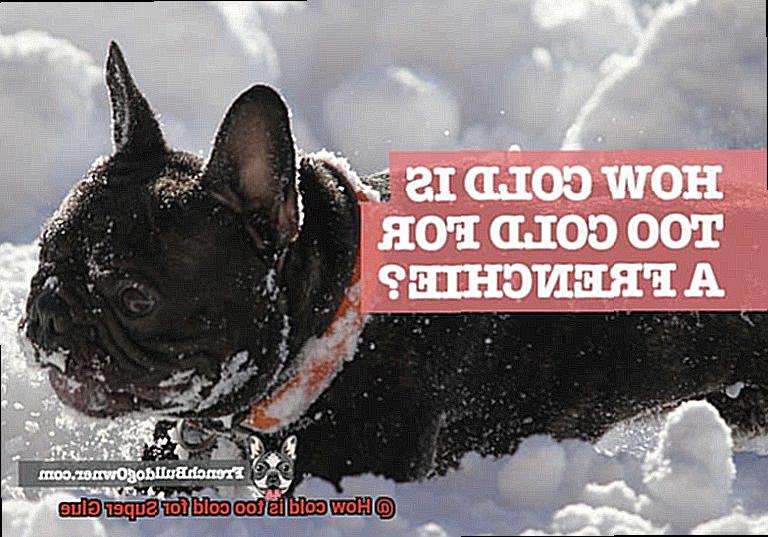
So, grab your parka and get ready for some freeze-worthy bonding. Let’s jump right in.
Optimal Temperature for Super Glue
Contents
- 1 Optimal Temperature for Super Glue
- 2 Effects of Low Temperatures on Super Glue
- 3 Recommended Temperature for Using Super Glue
- 4 Freezing Temperatures and Super Glue
- 5 Frost and Moisture Interference with Bonding Process
- 6 Compromised Effectiveness in Colder Temperatures
- 7 Storing Super Glue in a Temperature-Controlled Environment
- 8 Specialized Formulations for Cold-Resistant Super Glue
- 9 Conclusion
Crafters, woodworkers, and DIY enthusiasts all know the power of super glue. Its lightning-fast bonding capabilities make it an essential tool in any toolbox. But did you know that the temperature at which you use super glue can affect its effectiveness? In this article, we will delve into the optimal temperature range for super glue to bond effectively. Get ready to unlock the secrets of perfect bonding.
The Perfect Temperature Range:
For super glue to work its magic, the optimal temperature range is typically between 70 to 90 degrees Fahrenheit (21 to 32 degrees Celsius). Within this range, the curing process happens at the ideal pace, resulting in bonds that are strong and durable. So, why is temperature so crucial? Let’s find out.
The Cold Challenge:
When temperatures drop below the optimal range, super glue’s curing process slows down significantly. This not only extends bonding times but also weakens the overall strength of the bond. In extreme cold conditions, super glue may even freeze, losing its adhesive properties altogether. Frost and moisture can also interfere with the bonding process, making it difficult to achieve desired results.
Handling Heat:
On the flip side, excessive heat can cause super glue to cure too quickly, leading to brittle bonds that may not hold up well over time. To strike a balance, avoid direct sunlight or extreme temperature fluctuations during storage. Extreme heat can also affect the viscosity of super glue, making it thicker and harder to apply smoothly.
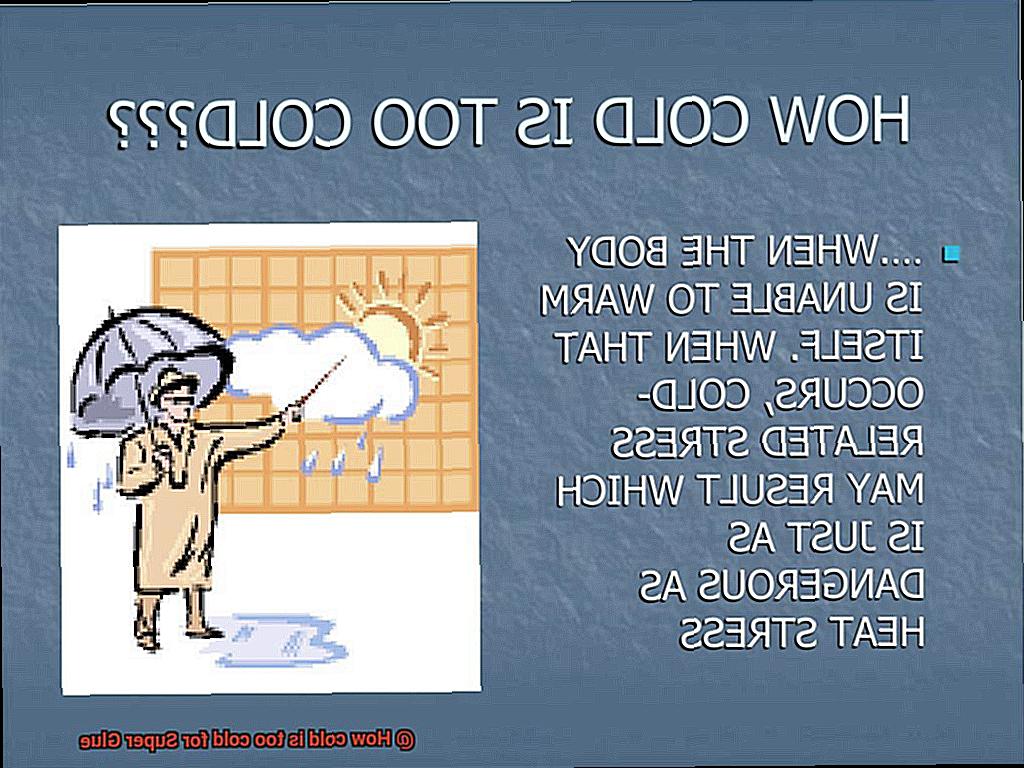
Tips and Tricks:
To ensure optimal bonding even in colder temperatures, here are some helpful tricks: pre-warm the surfaces being bonded or use a heat source like a hairdryer. These methods can improve the bonding process. Just remember to exercise caution to prevent any damage or warping of the materials being glued.
Effects of Low Temperatures on Super Glue
Today, we’ll explore what happens when this adhesive hero faces its nemesis: low temperatures. Get ready for some mind-blowing facts about how super glue battles the cold.
Effects on Bonding:
Super glue loses some of its powers in chilly weather. The chemical reaction that makes it strong requires warmth to activate. In colder temperatures, this reaction slows down, leading to weaker bonds and longer drying times. So, keep this in mind for your winter DIY projects.
Viscosity Changes:
Super glue is known for flowing into tiny gaps, but in cold environments, its viscosity increases. It becomes thicker and struggles to spread evenly or penetrate surfaces effectively. It’s like the glue is putting on a winter coat and losing its agility – not ideal for creating solid bonds.
Brittleness and Cracking:
In low temperatures, super glue becomes a fragile ice sculpture. It loses flexibility and cracks under stress or impact. So, be cautious during icy weather if you’re bonding materials that move or vibrate frequently.
Freezing Point:
Yes, even super glue can freeze. When temperatures drop enough, the water molecules in the adhesive can freeze too. This means the glue won’t bond surfaces until it thaws out – not very helpful for a quick fix. Most super glues start losing effectiveness below 50°F (10°C), and below freezing (32°F or 0°C), things can go downhill fast.
Solutions:
But fear not, fellow DIYers. We have some tricks up our sleeves to fight back against the cold. One option is to warm up the surfaces before applying the glue using a heat gun or letting them reach room temperature. This speeds up the curing process for stronger bonds.
Alternatively, you can use specialized super glues designed for cold weather applications. These mighty glues maintain their bonding properties even in chilly conditions. Look for those with additives or modified formulations that cure effectively in the cold.
For an extra boost, consider using an accelerator or activator spray. These sprays contain chemicals that speed up the curing process, compensating for the slow effects of low temperatures.

Recommended Temperature for Using Super Glue
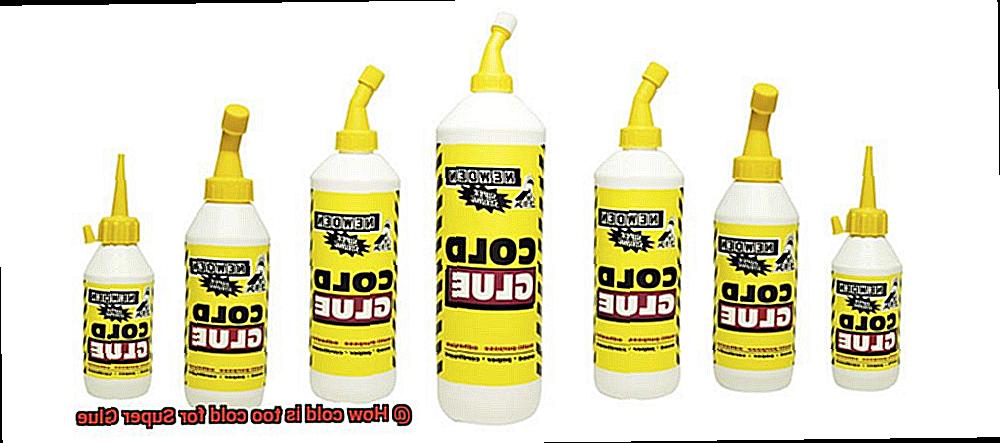
Today, we tackle a crucial aspect that often goes unnoticed in our super glue adventures: temperature. Just like us, super glue has its comfort zone, and knowing the recommended temperature range can make all the difference in achieving a successful bond. So, grab a warm beverage and let’s explore the world of optimal bonding temperatures.
Imagine this scenario: you have a broken vase that needs fixing. The sweet spot for using super glue typically falls between 50°F and 77°F (10°C and 25°C). This cozy room temperature is like a warm embrace for your glue, allowing it to reach its peak bonding strength.
The Cold Truth:
But what happens during the frosty winter months when Jack Frost freezes everything in sight? Well, super glue doesn’t fare well in extremely cold temperatures, especially below freezing. In these icy conditions, it may stubbornly refuse to cure at all, leaving you with frustratingly incomplete bonds. Brrr.
Tips for Cold Weather Projects:
If you’re determined to take on a project in colder environments, fear not. We’ve got some handy tricks up our sleeves. First, pre-warm the materials you’ll be gluing together – this will give your super glue a fighting chance. Additionally, using a gentle heat source like a hairdryer or heat gun on low settings can expedite the curing process and help create a robust bond. Winter won’t stand a chance against your resourcefulness.
The Heat Hazard:
Now let’s turn up the heat and talk about scorching summers and sizzling temperatures. Excessive heat can cause super glue to cure too quickly, resulting in a weaker bond. So, when the mercury rises above 100°F (38°C), it’s best to avoid using super glue altogether – give it a break and indulge in a refreshing glass of lemonade instead.
Manufacturer’s Instructions:
Remember, different types of super glue may have slightly different temperature requirements. To avoid any mishaps, always consult the manufacturer’s instructions for specific guidance. They know their glue best.
Freezing Temperatures and Super Glue
Super glue, also known as cyanoacrylate adhesive, has gained immense popularity for its ability to create strong bonds on various materials. However, like many other adhesives, super glue can face challenges when exposed to extreme temperatures. In this blog post, we will dive into the impact of freezing temperatures on the effectiveness of super glue and explore some tips to combat this chilly challenge.
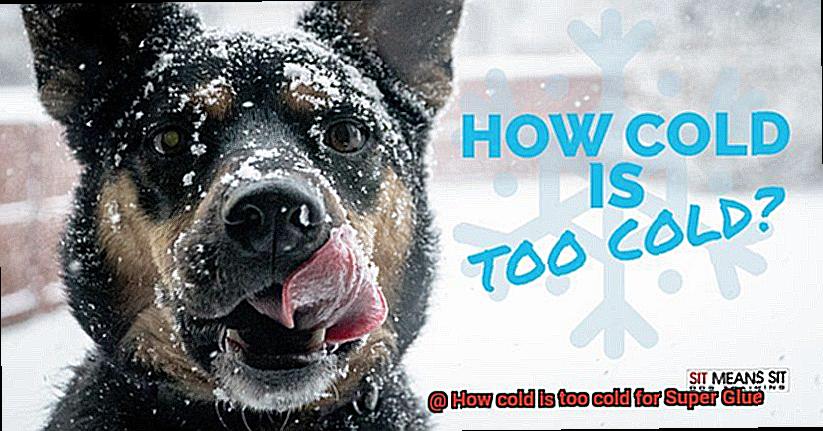
The Science Behind the Struggle:
- Brittle Bonds: Freezing temperatures turn super glue brittle and inflexible, compromising its ability to create strong bonds. This leads to weakened adhesion or even complete loss of bonding properties.
- Ice Crystal Intruders: When exposed to freezing temperatures, the moisture within the glue freezes and forms ice crystals. These intruders disrupt the bond between the adhesive and the surfaces it is trying to bond, further weakening the overall strength of the bond.
Navigating the Temperature Terrain:
- Recommended Working Temperature Range: Most super glues come with a recommended working temperature range indicated on their packaging. Stick to these guidelines to avoid compromising the adhesive’s effectiveness.
- Storage Matters: Protect your super glue from freezing temperatures by storing it at room temperature or in a cool, dry place. Avoid exposing it to extreme cold or storing it in freezing environments such as the freezer.
- Pre-Warming Surfaces: Improve adhesion in colder conditions by pre-warming the surfaces you intend to bond. This step ensures that both the adhesive and the surfaces are at a suitable temperature for bonding.
- Specialized Cold-Resistant Adhesives: Consider using thicker formulations of super glue or specialized cold-resistant adhesives designed specifically for cold environments. These products provide better results when working in freezing temperatures.
The Road to Restoration:
If a bond fails due to cold temperatures, don’t lose hope. Super glue can regain its bonding properties once the temperature rises. Simply reapply the glue and allow it to cure at room temperature, and you should see the bond restored.
Frost and Moisture Interference with Bonding Process
Or perhaps you’ve noticed a mysterious white haze on cured super glue surfaces. Well, frost and moisture may be the culprits behind these issues. In this article, we will delve into how these elements interfere with the bonding process of super glue, offering valuable insights and practical tips to overcome these challenges.

The Frosty Barrier:
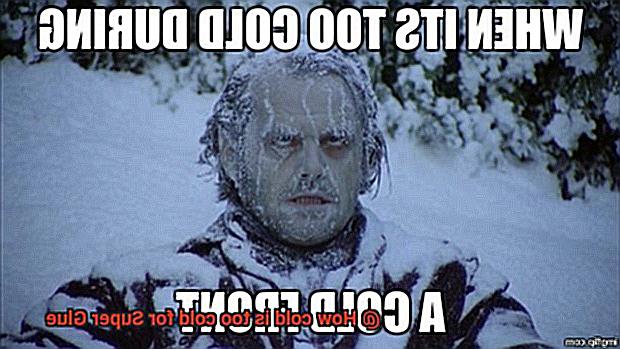
When temperatures plummet below freezing point, frost forms, creating a delicate layer of ice on surfaces. This ice acts as an insidious barrier between the adhesive and the surface it aims to bond. The consequence? Feeble bonds or even complete failure. Additionally, the low temperature slows down the curing process of super glue, rendering it less effective.
Moisture’s Sneaky Role:
Moisture, whether in liquid or humid form, can also wreak havoc on super glue bonds. Water molecules possess positive and negative charges that can interact with adhesive molecules, compromising their ability to form robust bonds. This interaction leads to blooming, a cloudy appearance on cured super glue surfaces caused by the reaction between moisture and the adhesive.
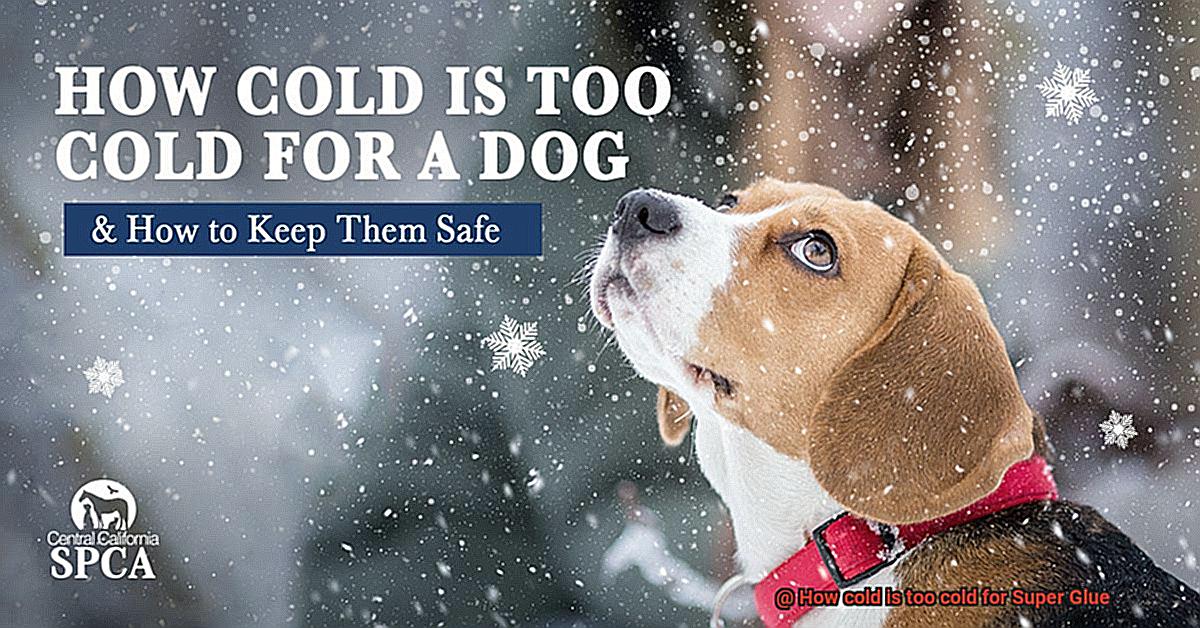
Combatting Frost and Moisture:
To ensure optimal bonding strength, it is crucial to commence with clean and dry surfaces. The presence of any moisture or contaminants can jeopardize the bond’s integrity. Moreover, bringing both the surfaces and the super glue to room temperature before bonding is advisable. This can be achieved by storing them in a warm environment for a period of time. By equalizing temperatures, the risk of frost formation and moisture interference is minimized.
Specialized Solutions:
Consider employing primers or accelerators specifically tailored for low-temperature applications. These products enhance the adhesive’s ability to bond in frosty or moist conditions, resulting in stronger and more reliable bonds.
Compromised Effectiveness in Colder Temperatures
We’ve all experienced the frustration of super glue letting us down in colder temperatures. But fear not. In this blog post, we’ll explore the world of super glue and uncover why cold temperatures compromise its effectiveness. So grab a warm cup of cocoa and let’s dive in.
The Lowdown on Super Glue and Cold Temperatures:
Super glue, also known as cyanoacrylate adhesive, is the go-to adhesive for bonding materials. However, it turns out that this versatile adhesive isn’t so fond of the cold. Here’s why:
Sluggish Curing Process:
When the temperature drops, the chemical reaction that hardens super glue slows down. This means it takes longer for the glue to cure and form a strong bond. In some cases, it may not cure at all, leaving you with a weak or ineffective bond.

Thick and Tricky:

As the mercury plunges, so does the viscosity of your super glue. In simpler terms, it becomes thicker and more difficult to apply evenly. Achieving a uniform bond between two surfaces becomes quite the challenge.
Moisture Matters:
Moisture is usually super glue’s best friend for quick curing. However, in cold and dry conditions, the lack of moisture can slow down the curing process and weaken the bond. Mother Nature can be quite fickle.
Specialized Solutions for Cold-Resistant Bonds:
Luckily, all hope is not lost. Some specialized super glues are designed to brave colder temperatures and maintain their effectiveness. These cool-resistant variants often contain additives that enhance their performance in chilly environments.
Tips for Optimal Bonding Strength:
To achieve stronger and more reliable bonds in colder temperatures, follow these handy tips:
Warm It Up:
Before applying super glue, warm up the surfaces being bonded. Use a hairdryer or place the objects near a heat source briefly. This increases the curing speed of the glue and improves bonding strength.
Choose Wisely:
Consider using a cold-resistant formulation of super glue for chilly conditions. This can save you from disappointment and ensure a stronger bond.
Conclusion:
Now armed with knowledge about the impact of cold temperatures on super glue, you can take precautions for successful bonding even in chilly conditions. Warm up your surfaces and consider using a cold-resistant variant for frosty projects. Don’t let the chill ruin your bonds—embrace winter challenges and conquer them with the power of super glue.
Storing Super Glue in a Temperature-Controlled Environment
When it comes to storing super glue, maintaining a temperature-controlled environment is of utmost importance. This small step can make all the difference between a successful adhesive bond and a frustrating gummy mess. Let’s dive deeper into the topic and explore why temperature control is crucial when it comes to storing super glue.
First and foremost, let’s address the issue of extreme cold temperatures. Super glue, also known as cyanoacrylate adhesive, does not fare well in chilly conditions. When exposed to low temperatures, this adhesive can transform into a stubborn, frozen popsicle. Its consistency thickens, turning gummy and nearly impossible to apply and bond properly. Your flawless DIY project can quickly turn into a sticky disaster.
To avoid this undesirable outcome, it is essential to store your super glue in a temperature-controlled environment. Aim for an area where the temperature remains between 50°F (10°C) and 77°F (25°C). By doing so, you ensure that your adhesive remains in its prime condition, ready to work its magic whenever you need it.
Now let’s shift our focus to another culprit: excessive heat. Just like humans, super glue dislikes scorching temperatures. When subjected to high heat, the adhesive begins to degrade, losing its bonding properties faster than you can say “hot potato.” Direct sunlight and heat sources like radiators or ovens should be avoided when storing super glue.
To maintain the effectiveness of your super glue, strive for a cool and dry storage location that is shielded from temperature fluctuations. A climate-controlled cabinet or drawer serves as an excellent option for preserving the integrity of this adhesive wonder.
Specialized Formulations for Cold-Resistant Super Glue
When faced with freezing temperatures, regular super glue loses its adhesive properties, leaving us out in the cold. But fear not, for there is a solution – specialized formulations for cold-resistant super glue. These mighty adhesives are designed to withstand even the chilliest of conditions, thanks to their modified cyanoacrylate, flexible additives, and specialized curing processes.
At the heart of cold-resistant super glue lies the trusty cyanoacrylate, the main component found in most types of super glue. However, in these specialized formulations, cyanoacrylate undergoes a transformation to enhance its bonding capabilities in low-temperature environments. It’s like giving the glue a little winter coat to keep it warm and flexible.
But wait, there’s more. To further bolster its resistance to the cold, cold-resistant super glues often contain additives such as rubber or plasticizers. These magical ingredients increase the flexibility of the glue, allowing it to endure the expansion and contraction that materials experience in freezing temperatures. So not only does it stick like a champ, but it also stays pliable in the face of icy adversity.
The curing process of cold-resistant super glue is also tweaked to ensure effective bonding at low temperatures. This can involve adjusting the ratio of activator chemicals or utilizing alternative curing methods better suited for chilly conditions. It’s all about finding that perfect balance between bond strength and cold resistance.
Now, before you rush out to buy any old super glue for your next Arctic adventure, remember that not all brands or formulations are created equal. Regular super glue may lose its adhesive properties when faced with freezing temperatures, leaving you out in the cold (literally). Look for products specifically labeled as “cold resistant” or “freezer safe” to ensure your adhesive can handle the frosty challenges ahead.
Cold-resistant super glues find their homes in various industries, from automotive repair to construction and even outdoor equipment manufacturing. But keep in mind that while these glues can brave the freezing cold, extreme temperatures can still affect their performance. Always follow manufacturer guidelines and test the glue in controlled conditions before relying on it in critical applications under harsh cold.
Also Read: What Temperature Does Super Glue Melt?
Conclusion
When it comes to Super Glue, extreme cold can be a deal-breaker.
The freezing temperatures can cause the adhesive to lose its effectiveness, leaving you with a weak bond or no bond at all. So, how cold is too cold for Super Glue?
Well, if the temperature drops below 32 degrees Fahrenheit (0 degrees Celsius), you might want to think twice before reaching for that trusty tube of glue. At such frigid temperatures, the glue can become brittle and prone to cracking, making it virtually useless.
So, whether you’re working on a DIY project outdoors or storing your Super Glue during the winter months, make sure to keep it away from subzero temperatures.


